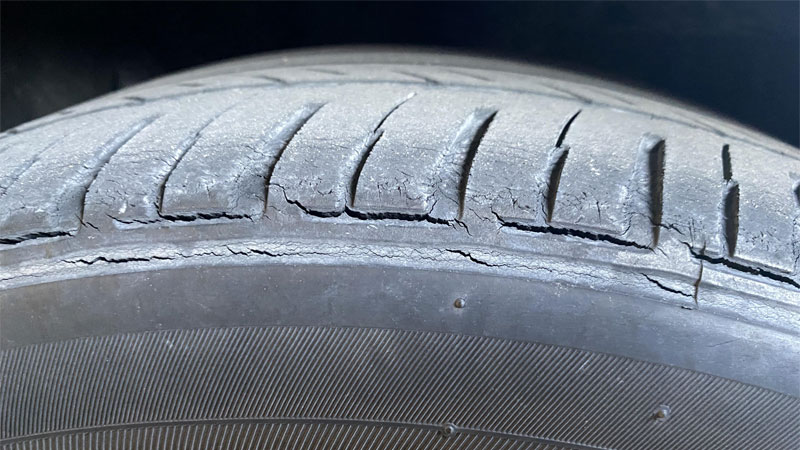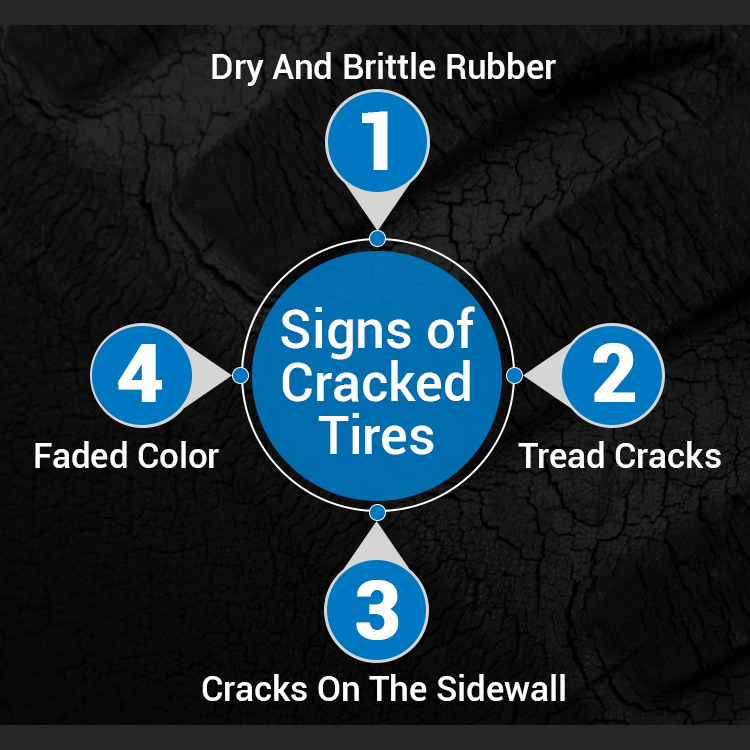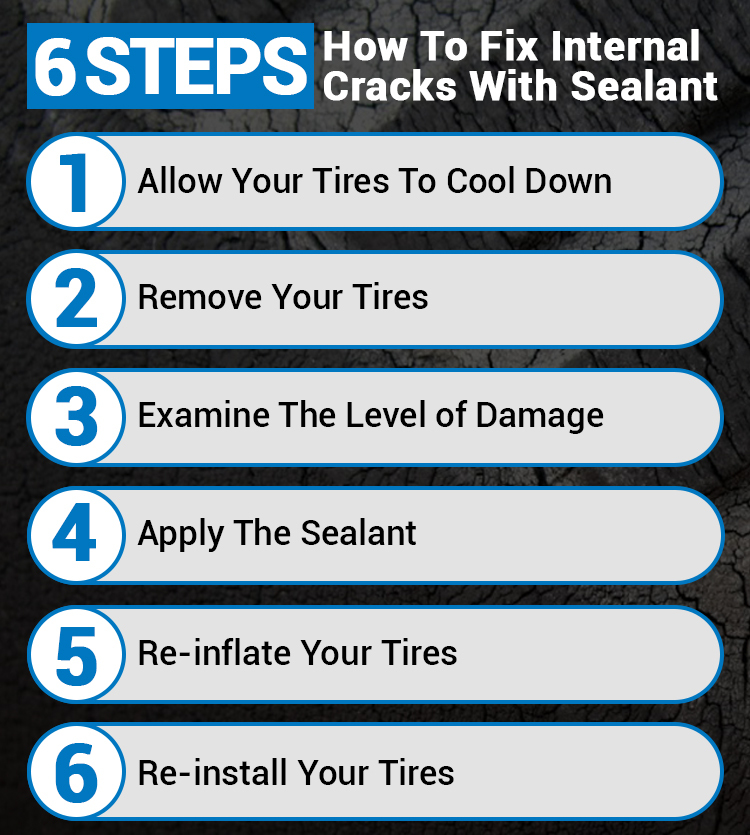The sight of cracked tires can ruin your day.
While small cracks in tires are often normal and purely cosmetic, it’s the larger, more noticeable cracks you need to worry about. Moderate to severe tire cracks can affect your vehicle’s drivability and become a huge safety risk if ignored.
To avoid putting your safety in jeopardy, it’s imperative to learn how to identify the severity of cracks in your tires and take appropriate action when necessary. Let’s look at some common signs of tire cracking, what causes this issue, and how to fix the problem.
What Are the Signs of Cracked Tires?
It’s fairly easy to notice cracked tires. The following are signs that appear when there are cracks on your vehicle’s tires:
1. Dry and Brittle Rubber
The rubber parts of tires are protected by oils and antioxidants. Frequent usage can make these protective compounds wear away. This makes your tires appear dry and brittle when felt.
2. Cracks on the Sidewall
Ever noticed splits and cracks on the sidewalls of your tires? They can appear on both sides and are the clearest sign that you have cracked tires.
3. Tread Cracks
Cracks can also appear on your tire tread’s outer edges. This is usually caused by dry rot at an advanced stage. The cracks might look small, but they can compromise your car’s handling even when the tread still has enough depth.
4. Faded Color
When your car tire’s black color begins to turn grey, there’s a chance it’s due to dry rot. Sometimes, the color starts fading before cracking happens. However, they can both happen at the same time as well.
What Causes Cracked Tires?

1. When Your Car Sits Unused for a Long Time
Storing your car in a garage and leaving it unused for a long period can leave the engine in a bad condition. But it can also suffer further damage due to dry rot. As earlier mentioned, tires are protected by oils and antioxidants.
When left unused, these protective compounds can evaporate or leach into the ground. This effectively removes your car’s protective layer, making it vulnerable to cracking.
2. Aging
Like humans, cars age with time. The older they get, the less efficient their parts become. This is also true for car tires. After a while, the rubber begins to age, and dry rot sets in. The aging process can also be accelerated by heavy use.
With your tires running for many miles every day and being exposed to various elements, it will start to crack.
3. Extreme Temperature and Humidity
Extreme temperature and humidity are some of the elements that can cause your tires to deteriorate. While this process is gradual under normal conditions, it accelerates when the temperature is particularly high.
When the temperature is low, the rubber becomes rigid as it dries out. This allows dry rot to set in faster. Similarly, when the temperature is high, sunlight breaks down the rubber’s protective compounds causing tires to crack rapidly.
4. Low-Quality Tires
If your tires are made with low-quality materials, you can bet on dry rot to set in easily. Tires face different elements as well as static friction between them and the road. If the rubber and other components are substandard, the cracking process will happen much faster causing your tires to deteriorate at an alarming speed.
5. Over or Under Pressurized Tires
It’s crucial to get your car’s pressure right to avoid the effects of under or over-pressurized tires. One such effect is dry rot. When the tires are over-pressurized, there’s additional stress on the walls which may lead to bulging and eventually cause cracks.
On the other hand, under-pressurized tires experience more friction with the road. This causes dry rot.
See Also – Tire Pressure Sensor Fault (Causes and How to Fix)
How To Fix Cracked Tires: A Step-By-Step Guide
When dry rot sets in, you have the option to change your tires. But If you’re not too thrilled with the idea of replacing your tires every year, it’s best to learn how to fix them. Below are steps to fix your cracked tires.
Method No. 1: Fix Internal Cracks With Sealant
You can fix your cracked tires with sealants when the cracks are small and not obvious. To ensure this method is done right, you need to buy a sealant that’s suitable for your tires.
Here are the tools you need:
● Dry rot sealant that suits your tires
● Tire inflator
● Tire pressure gauge
● 1/2” Socket wrench or Lug wrench
Step-by-Step Guide
Follow the steps below to fix your tires with a sealant:
Step No. 1: Allow Your Tires to Cool Down
As you may have noticed, your vehicle naturally heats up when driven. For tires, the heating up is a result of the friction between them and the ground. If you’ve recently driven your car, allow it to cool down before you fix the cracks with a sealant.
Step No. 2: Remove Your Tires
The next step is to jack up your vehicle and remove the affected tires. You can’t fix tires properly if they are not attached to your car. Therefore, you’ll need the lug wrench or the 1/2” socket wrench to take off your tires to allow you to fix them properly.
Step No. 3: Examine the Level of Damage
The level of tire damage will confirm if your tires are fixable or they need to be replaced. This inspection also allows you to see the area that’s damaged. With a clear idea of the situation, you can come up with a good plan to fix the tires.
Step No. 4: Apply the Sealant
Depending on the kind of sealant, you might need to prepare it according to the instructions. However, some sealants don’t need any special preparation. You can apply them right away. To apply the sealant on the insides of your tires, insert the injector into the valve stem.
Step No. 5: Re-inflate Your Tires
With the sealant applied, your tires may have lost some air. Therefore, you need to re-inflate them. Use the pressure gauge to ensure you get the pressure right.
Step No. 6: Re-install Your Tires
With your tires fixed, re-install them on your car. Some sealants require you to drive your car around immediately after installing. This helps the sealant to circulate and seal the cracks adequately.
Method 2: Fix External Cracks With Protectant
For visible cracks, this method is ideal. A protectant can fix cracks and help protect the rubber from UV rays.
You’ll need the following tools:
● Water hose
● Large sponge
● Water-based tire degreaser
● Tire protectant
Step-By-Step Guide
Step No. 1: Allow to Cool, Remove, and Inspect Your Tires
Like the first method, you need to wait till your tires are cool before taking them out to examine. The inspection will show where the major problem is and if it’s fixable.
Step No. 2: Apply Degreaser
With the large sponge, apply the degreaser to your tires. Be sure to apply it to every area of the tires while focusing on the cracked areas. Scrub thoroughly to get the degreaser on the tire’s entire surface.
Step No. 3: Wipe and Rinse the Tires
After applying the degreaser, allow your tires to dry. When dry, wipe down with a clean cloth and rinse with the water hose.
Step 4: Apply Tire Protectant
When the tires are dry from rinsing, apply the tire protectant. Following the instructions on the protectant, spray it across the tires’ entire surface.
Step 5: Re-Install And Check Your Tires Again
When you’ve sprayed your tires, the cracks should be fixed. You can re-install your tires on your car. If you still see signs of dry rot, repeat the process for better results.
Preventing Tire Cracks
Your tires can’t stay new forever, but with the following measures, you can keep extending their lifespan and keep them from cracking too soon:
● Don’t buy low-quality tires
● Clean regularly
● Cover your car when parked outside
● Maintain ideal tire pressure
● Examine your tires regularly
● Apply protectants frequently
See Also – What Are Radial Tires?
- What the Letters and Numbers On an Automatic Gear Shift Mean - Sep 12, 2022
- How Long Does it Take to Change Tires? (Professional vs DIY) - Jun 8, 2022
- 2022 Ford Bronco EcoBoost Performance & Off-Roading Specs - Jun 2, 2022





